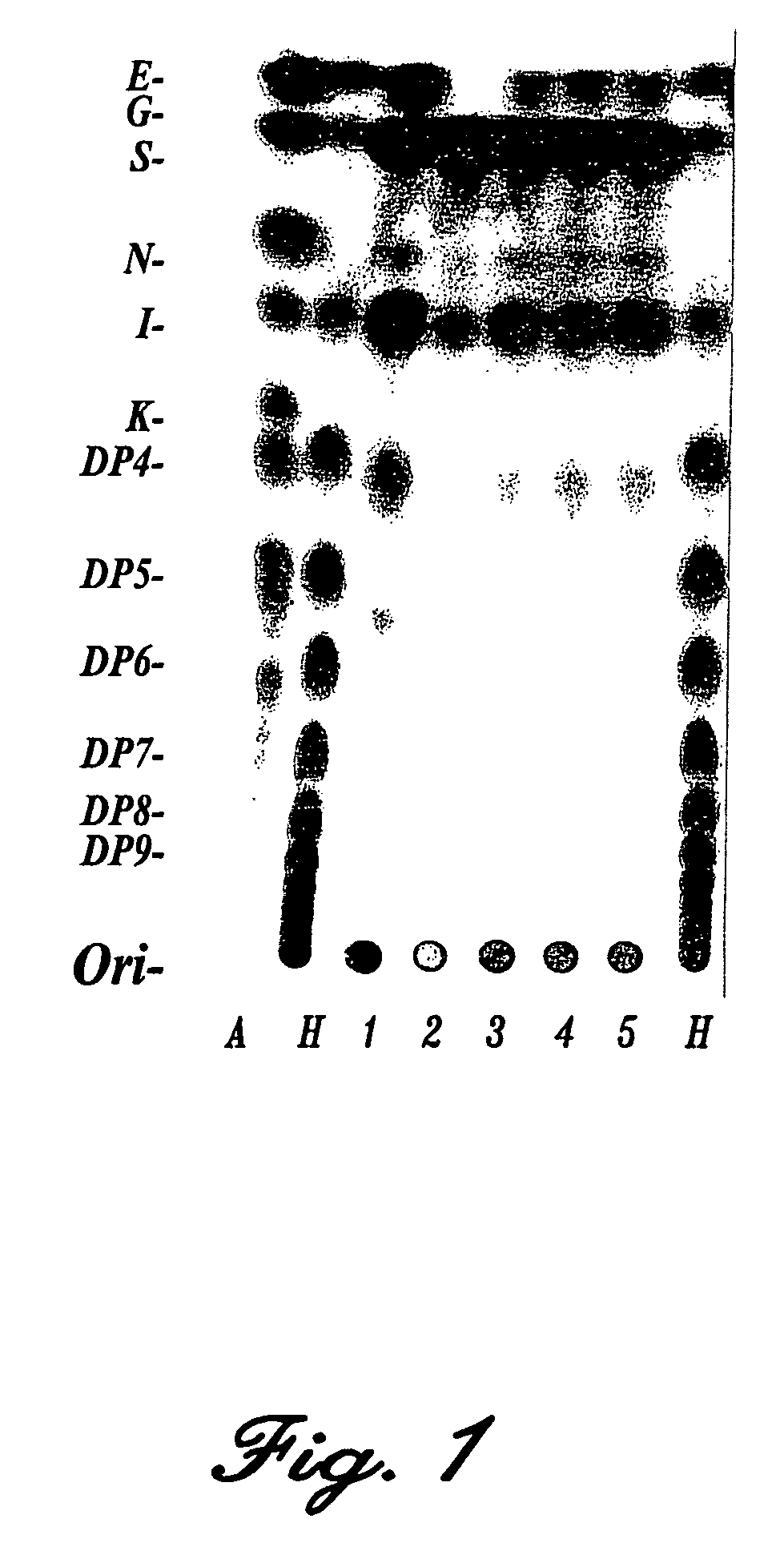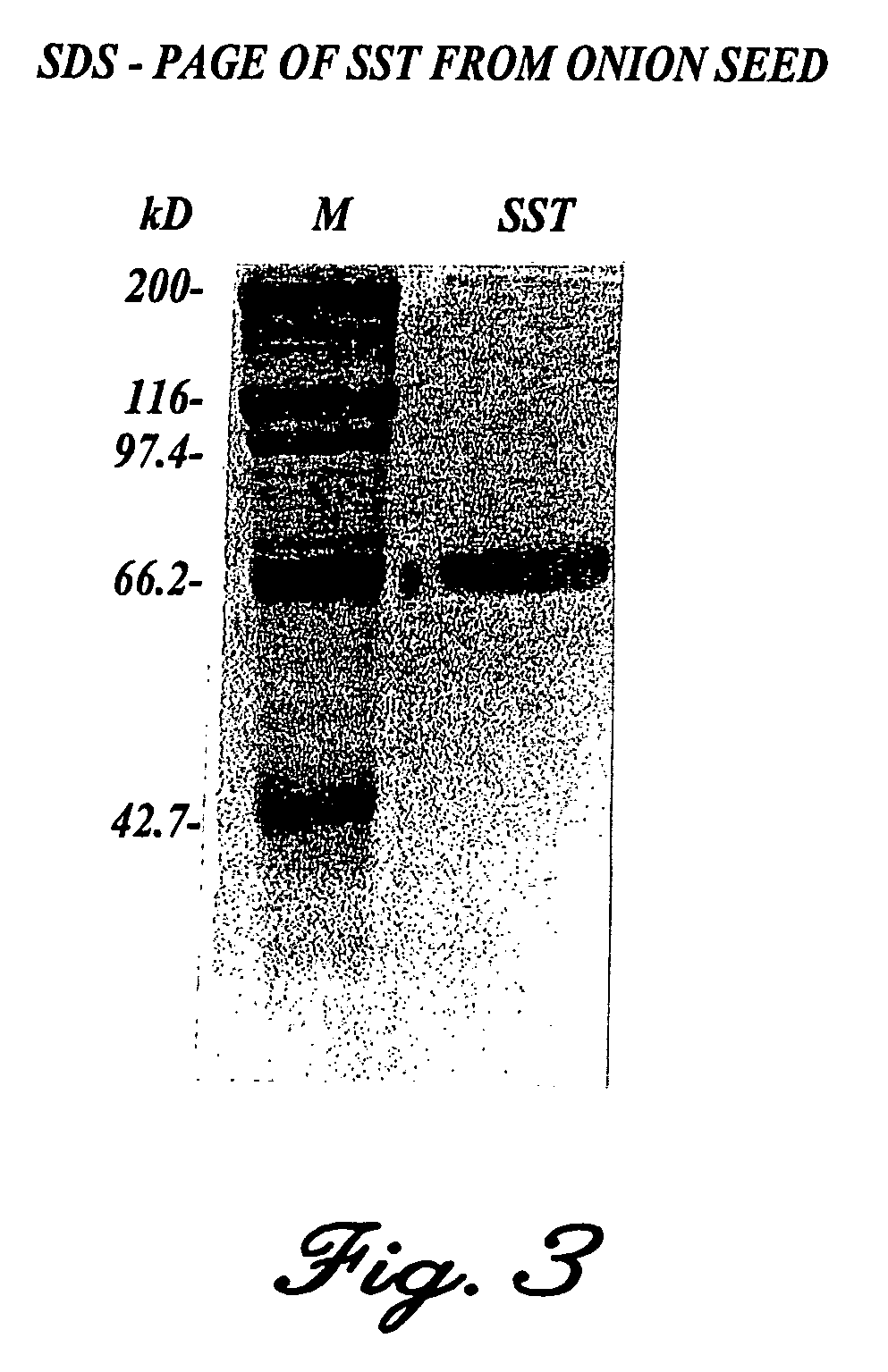Production of oligosaccharides in transgenic plants
- Summary
- Abstract
- Description
- Claims
- Application Information
AI Technical Summary
Benefits of technology
Problems solved by technology
Method used
Image
Examples
example 1
Selection of a Gene.
1. Naturally Occurring Genes
[0098]A large number of microbes were screened for their capacity to produce oligosaccharides from sucrose. For this purpose bacteria cultures were grown overnight in a liquid nutrient. The oligosaccharide-producing activity was determined by incubating a sample of the culture with 200 mM sucrose in the presence of 0.1% Triton X-100. The reaction products were separated by means of TLC and made visible using a fructose-specific reagent (Cairns, A. J. and Pollock, C. J., New Phytol. 109, 399-405 (1988)). It was found as a result of this screening that Streptococcus mutant is an effective producer of oligosaccharides (see FIG. 1). The oligosaccharide-producing enzymatic activity was purified from the Streptococcus mutans culture by means of DEAE-ion exchange chromatography and gel permeation chromatography. It was found herefrom that the enzymatic activity was caused by the product of the ftf gene previously described by shiroza and Kura...
example 2
Expression of the ftf Gene in Plants.
A. Construction of 35S-ftf-NOS in a Plant Transformation Vector.
[0106]The plasmid pMOG18 which contains a plant-specific 35S promotor with an enhancer duplication and sequences which stimulate the translations of mRNA is described by Symons et al., (Bio / Technology 8, 217-221 (1990). It contains the 35S-promotor-uidA-gene-NOS-terminator construct. A pBluescript II SK-plasmid from Stratagene (San Diego, Calif., U.S.A.), from which the internal BamHI-site was removed by digestion with BamHI and filling in the sticky ends with Klenow and ligating once again, was used for further cloning. The 35S-uidA-NOS-fragment was obtained by digestion with EcoRI and HindIII of pMOG18 and in this BamHI-pBluescript was cloned in the corresponding EcoRI / HindIII site, resulting in plasmid pPA2. Plasmid pPA2 was digested with NcoI and BamHI and the vector-containing fragment was isolated.
[0107]The fructosyltransferase gene ftf was cloned from the plasmid pTS102 (see a...
example 3
Oligosaccharide-producing Enzyme (SST) from the Onion.
[0112]In addition to the above used fructosyltransferase genes originating from micro-organisms, such enzymes are also produced by plants. In this example the SST gene from onion seed is used.
[0113]The SST protein from onion seed was purified by chromatographic procedures making use of the following protocol: the seed was incubated at 22° C. between moist cloths for 2 to 3 days and homogenised in 50 mM phosphate-citrate buffer with a pH of 5.7. The starch and debris were centrifuged off at about 10,000 g for 10 minutes. Ammonium sulphate was added to the supernatant to 20%, and the precipitate collected by centrifugation. The concentration of ammonium sulphate in the supernatant was increased to 80%, and the precipitate collected and dissolved in 20 mM NaAc pH 4.6. The solution was dialysed overnight with three buffer changes (20 mM NaAc) and the solution was clarified by centrifugation. The supernatant was placed on an FPLC mono...
PUM
| Property | Measurement | Unit |
|---|---|---|
| Fraction | aaaaa | aaaaa |
| Fraction | aaaaa | aaaaa |
| Mass | aaaaa | aaaaa |
Abstract
Description
Claims
Application Information
 Login to View More
Login to View More - R&D
- Intellectual Property
- Life Sciences
- Materials
- Tech Scout
- Unparalleled Data Quality
- Higher Quality Content
- 60% Fewer Hallucinations
Browse by: Latest US Patents, China's latest patents, Technical Efficacy Thesaurus, Application Domain, Technology Topic, Popular Technical Reports.
© 2025 PatSnap. All rights reserved.Legal|Privacy policy|Modern Slavery Act Transparency Statement|Sitemap|About US| Contact US: help@patsnap.com



